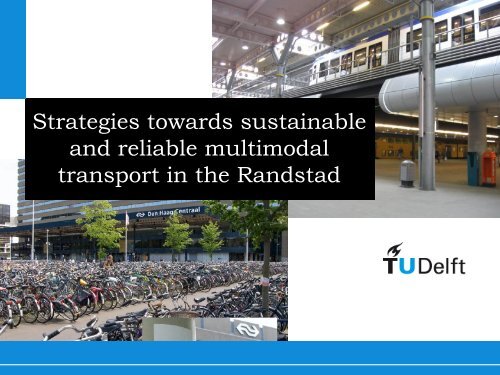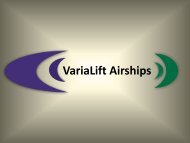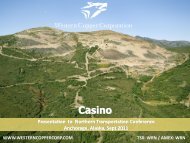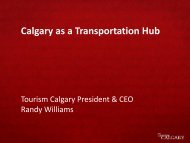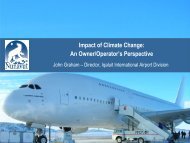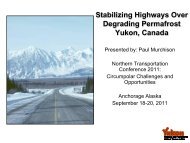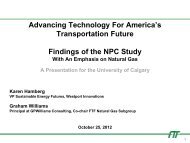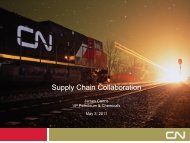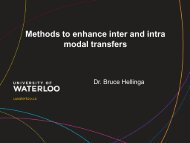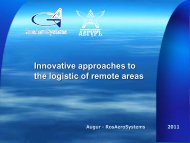Dr. Ingo Hansen, Professor, TU Delft, Netherlands - Van Horne ...
Dr. Ingo Hansen, Professor, TU Delft, Netherlands - Van Horne ...
Dr. Ingo Hansen, Professor, TU Delft, Netherlands - Van Horne ...
Create successful ePaper yourself
Turn your PDF publications into a flip-book with our unique Google optimized e-Paper software.
Strategies towards sustainable<br />
and reliable multimodal<br />
transport in the Randstad
Contents<br />
1. Introduction Randstad land-use and transport<br />
2. Randstad 2040 development strategy<br />
3. Research program Sustainable Accessibility of the Randstad<br />
(SAR)<br />
4. Research program Strategies towards sustainable and reliable<br />
multimodal transport in the Randstad (SRMT)
Metropolitan areas in northwestern Europe
Urban areas in the <strong>Netherlands</strong><br />
International accessibility<br />
of urban areas with top value<br />
Amsterdam<br />
The Hague<br />
Randstad<br />
Utrecht<br />
Rotterdam
Randstad <strong>Netherlands</strong><br />
Polycentric area Amsterdam-Haarlem-Leiden-The Hague-<strong>Delft</strong>-<br />
Rotterdam-Dordrecht-Utrecht-Amersfoort-Hilversum-Almere<br />
Size 80 km x 80 km<br />
2010 2040<br />
Inhabitants: 7 million 8 million<br />
‘Green Heart’
Major transport flows, corridors and<br />
mainports/brainports/top business locations
Randstad 2040 development strategy<br />
• Scaling up and accessibility<br />
improvement of the urban regions<br />
through higher use of public<br />
transport and better coordination<br />
with road transport<br />
• Linking space and mobility by<br />
consolidation and creation of<br />
urban centres<br />
• Optimal use of city centre space<br />
making it climate resilient through<br />
transformation, restructuring and<br />
intensification
Randstad 2040 development strategy
Randstad 2040 development strategy
Functions and accessibility of centres<br />
International Randstad Regional<br />
Functions<br />
Head offices<br />
Head offices<br />
Offices<br />
Top musea<br />
Universities<br />
Hospitals<br />
Top tourist<br />
attractions<br />
University hospitals<br />
Commercial centres<br />
Market places<br />
Urban housing<br />
Accessibility<br />
30 min<br />
0.75 – 1 million<br />
people<br />
0.5 - 0.75 million 0.5 million<br />
Accessibility<br />
60 min<br />
4 - 5 million 2 - 3 million 1 - 2 million<br />
Connectivity<br />
International<br />
(air)ports and HS<br />
train stations<br />
Intercity and<br />
HRRT stations,<br />
ports<br />
Regional<br />
railway<br />
stations
Main national goals of structural<br />
vision Infrastructure and Space<br />
1. Increase of competitiveness through strengthening of spatial-economic structure<br />
‣ Resolution of accessibility bottlenecks of main-/brain and greenports<br />
‣ Stimulation of spatial developments at national top locations<br />
‣ Transition towards sustainable, recoverable energy supply and distribution<br />
2. Improving, maintaining en assuring spatial accessibility<br />
‣ Robust main road, railway and inland shipping networks around the big urban areas and hinterland<br />
connections including good infrastructure management, maintenance and renovation<br />
‣ Reinforcement of transport supply by mode according to demand<br />
High-frequency, less interdependant intercity and regional train timetable (2 times 6 trains/h)<br />
Segregation of through traffic and local destination traffic on motorways<br />
Combination of national and regional PPP investment programs<br />
‣ Better intermodal connections, transport chains and multimodal nodes<br />
Timetable synchronisation between urban/regional bus and railway lines<br />
Good station/platform access and integrated real-time travel information<br />
Improvement/extension of P&R, B&R and logistic transhipment facilities<br />
‣ Increase of interrelationship with spatial development<br />
‣ Incentivising sustainable mobility demand<br />
3. Guaranteeing liveable and safe environment
Multimodal accessibility of Dutch municipalities 2030<br />
Number of daily arrivals<br />
Average weighted*<br />
accessibility indicator<br />
low (> 60 min)<br />
high (< 30 min)<br />
* Travel time x Place value
Public transport/car travel time ratio of city centres
Dutch railway network<br />
Existing routes<br />
High-frequent corridors<br />
Alternative freight<br />
corridors
Sustainable Accessibility of the Randstad<br />
(SAR) research program<br />
Universities<br />
- U Amsterdam<br />
- VU Amsterdam<br />
- <strong>TU</strong> <strong>Delft</strong><br />
- <strong>TU</strong> Eindhoven<br />
- U Utrecht<br />
- U Nijmegen<br />
- U Twente<br />
SAR<br />
2009-<br />
2015<br />
€10 M<br />
Disciplines<br />
- Transportation Planning<br />
- Urban Planning<br />
- Geography<br />
- Spatial Economics<br />
- Policy Analysis<br />
- Operations Research<br />
Value<br />
of<br />
recreation<br />
transport<br />
Synchronizing<br />
activity<br />
networks<br />
Sustainable<br />
multimodal<br />
freight<br />
transport<br />
Sustainable<br />
reliable<br />
multimodal<br />
networks<br />
Climate<br />
change,<br />
spatial<br />
development<br />
&<br />
transport<br />
Transport<br />
pricing<br />
policies<br />
Intelligent<br />
traveller<br />
information<br />
Mobility<br />
management<br />
Effects<br />
of<br />
transition<br />
to electric<br />
drive<br />
mobility<br />
Sustainable<br />
maintenance<br />
policy<br />
of infrastructure<br />
Implementing<br />
TOD<br />
TOD in<br />
Randstad<br />
south
Sustainable<br />
Accessibility of the<br />
Randstad<br />
Strategy towards<br />
sustainable and reliable<br />
multimodal transport in de<br />
Randstad<br />
Spatial<br />
economic<br />
behavior<br />
Integrated<br />
transition<br />
strategy<br />
Multimodal<br />
network<br />
design<br />
Dynamic<br />
multimodal<br />
network<br />
assessment<br />
Transit<br />
oriented<br />
traffic<br />
management
1. Transport system of the Randstad is<br />
heavily used<br />
2. Negative consequences<br />
Delay<br />
Unreliability<br />
Environmental damage<br />
Energy consumption<br />
Decreasing liveability<br />
Space consumption<br />
3. Prospects<br />
Background<br />
Growth in population and jobs<br />
Increasing mobility demand<br />
Bottlenecks will continue to exist<br />
Extra social costs<br />
4. Limitations<br />
Expansion of the car system is limited<br />
Political, financial, and safety constraints even in<br />
combination with ADAS, electric vehicles, traffic<br />
management, etc.
Mobility characteristics 2009 NL<br />
16.8 million trip/d, unimodal 97% - inter- & multimodal 3%<br />
Unimodal vs. Intra-, inter and multimodal pass.-km<br />
NL<br />
intermodal 8% intramodal & intermodal 2%<br />
other<br />
3%<br />
Main transport purpose NL<br />
visit<br />
leisure<br />
15%<br />
14%<br />
9%<br />
business<br />
shopping<br />
21%<br />
unimodal 89%<br />
Total 213.2 billion/d<br />
18%<br />
education<br />
20%<br />
work<br />
40,0%<br />
35,0%<br />
30,0%<br />
25,0%<br />
20,0%<br />
15,0%<br />
10,0%<br />
5,0%<br />
0,0%<br />
walk<br />
Main transport modal split<br />
1<br />
cycle<br />
moped<br />
motorcycle or<br />
scooter<br />
car driver<br />
car passenger<br />
bus passenger<br />
1 2 3 4 5 6 7<br />
Distribution of trip length all modes<br />
80,0%<br />
70,0%<br />
60,0%<br />
< 7.5 km<br />
50,0%<br />
7.5 - 15 km<br />
40,0%<br />
15 - 30 km<br />
30,0%<br />
30 - 50 km<br />
20,0%<br />
> 50 km<br />
10,0%<br />
0,0%<br />
1<br />
tram or metro
Relevance of multi-modal transport NL<br />
• Multi-modal person trips are niche market, albeit important:<br />
• 82% all train trips are multi-modal and intra-modal<br />
• 66% of all multimodal trips by train<br />
• 10% of total distance traveled is multi-modal<br />
• 15% of all inter-city trips to/from one city center is multi-modal<br />
• Above average multi-modal trips done<br />
for commuting and education<br />
<br />
<br />
over longer distances<br />
during peak hour periods.<br />
• Multi-modal person trips are important for sustainable cities<br />
• Present transit system is insufficient alterative
Composition of SRMT research program<br />
Project 1<br />
Spatial<br />
economic<br />
behavior<br />
Project 2<br />
Integrated<br />
transition<br />
strategy<br />
Project 3<br />
Multimodal<br />
network design<br />
Project 4<br />
Multimodal<br />
network<br />
assessment<br />
Project 5<br />
Transit oriented<br />
traffic<br />
management
Approach<br />
1. Use the strengths of each mode<br />
Often cars are sub-optimally used<br />
Offer high quality transit where it performs best<br />
2. Integrate different modes<br />
Offer private-public transfer connections<br />
Synchronize public transport services<br />
3. Integrate spatial and network planning<br />
Focus on spatial planning around stations<br />
4. Develop a transition strategy
1. Use the strengths of each mode<br />
1. Public transport<br />
High capacity<br />
Sustainable (energy, space, environment)<br />
Fast on large flow corridors<br />
2. Car<br />
Flexible<br />
Fast in low density areas<br />
3. Urban transit<br />
High capacity<br />
Increase local livability<br />
Sustainable<br />
4. Bicycle<br />
Flexible<br />
Sustainable
2. Integrate different modes<br />
1. The Randstad (Amsterdam-The<br />
Hague-Rotterdam-Utrecht)<br />
High concentrations of activities<br />
Train, bus, metro and tram available<br />
Bicycle facilities<br />
Limited space for cars<br />
Good conditions for sustainable modes<br />
- Multimodal trips<br />
Multiple modes will be used<br />
Combinations of modes<br />
Benefit from the strengths of both modes<br />
Modes support each other
3. Integrate spatial and network planning<br />
1. High density locations<br />
=><br />
High capacity transport systems<br />
Trains/Metro/Tram<br />
2. Widely spread origins and destinations<br />
=><br />
Flexible transport systems<br />
Car/Bicycle<br />
3. Locate activities near multimodal<br />
transfer nodes<br />
Investments more efficient<br />
No need to expand current urban space
4. Develop a transition strategy<br />
1. Transit oriented strategy<br />
2. Adaption of the strategy<br />
Actors (public, private, customers)<br />
Conditions (national, regional, local)<br />
3. Implementation<br />
Crucial actions for success<br />
Planning, coordination and coalition<br />
Integration transport and land use<br />
Accessibility<br />
Network<br />
Activities<br />
Land use
Research goals<br />
1. Develop strategies to come to a transportation system for the<br />
Randstad as sustainable as possible<br />
2. Focus on the design of a multimodal transport system and its<br />
interaction with spatial development<br />
3. Design and assess a set of promising networks<br />
4. Develop a transition strategy towards transit oriented development
Spatial economic behavior<br />
P1<br />
P3<br />
P2<br />
1. How does multimodal network<br />
design affects location choice<br />
decisions?<br />
Households<br />
Firms<br />
- And the other way around<br />
- Input for projects 2 and 3<br />
P4<br />
P5<br />
Spatial patterns<br />
Land use mechanisms
Integrated transition strategy<br />
P1<br />
P4<br />
P3<br />
P2<br />
P5<br />
1. How should a spatial and transport<br />
transition towards a sustainable<br />
transport system look like?<br />
2. Factors that hamper or facilitate<br />
transit oriented development<br />
Case studies abroad (Zurich, Karlsruhe, Napels)<br />
3. Apply these insights to the Randstad
Multimodal network design<br />
P1<br />
P4<br />
P3<br />
P2<br />
P5<br />
1. How should a multimodal network for<br />
the Randstad look like?<br />
Transit lines<br />
Frequencies<br />
Transfer facilities<br />
- Design promising network alternatives<br />
Multiple criteria<br />
Multiple stakeholders<br />
Different future scenario’s<br />
3. Test robustness<br />
Short term<br />
Long term
Transit oriented traffic management<br />
P1<br />
P4<br />
P3<br />
P2<br />
P5<br />
1. How to improve the reliability of<br />
multimodal travel chains by<br />
scheduling and traffic management ?<br />
Synchronize arrivals and departures<br />
Adjustment in case of disturbances<br />
2. Design stable and robust timetables<br />
For networks from project 3<br />
3. Estimate/simulate critical<br />
link/station/network capacity<br />
consumption and delay propagation
Multimodal network assessment<br />
P1<br />
P4<br />
P3<br />
P2<br />
P5<br />
1. How to assess the performance of<br />
dynamic large scale multimodal<br />
transport systems?<br />
Accessibility<br />
Sustainability (energy, livability, environment)<br />
- Lower level model for network<br />
optimization<br />
Network design<br />
Timetable design<br />
3. Detailed assessment of promising<br />
networks
References<br />
• Ministerie van Infrastructuur en Ruimte (2012), Structuurvisie Infrastructuur en Ruimte,<br />
http://www.rijksoverheid.nl/onderwerpen/ruimtelijke-ordening-en-bereikbaarheid/documenten-enpublicaties/rapporten/2012/03/13/structuurvisie-infrastructuur-en-ruimte.html<br />
• Minister of Housing, Spatial Planning and the Environment (2008), Randstad 2040 Summary of<br />
the Structural Vision, http://www.rijksoverheid.nl/documenten-en-publicaties/brochures/2009/03/01/randstad-<br />
2040-summary-of-the-structural-vision.html<br />
• OV Bureau Randstad (2011), Synergie tussen OV en RO, http://ov-bureaurandstad.nl/documenten<br />
• <strong>Netherlands</strong> Science Organisation (NWO), Sustainable Accessibility of the Randstad,<br />
http://www.nwo.nl/nwohome.nsf/pages/NWOA_794DXJ_Eng<br />
Strategies towards sustainable and reliable multimodal transport in the Randstad


